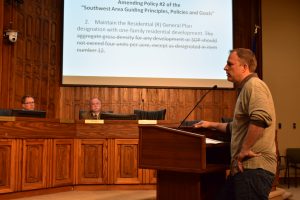
Editor’s note: This story pairs with Geographic income segregation pervasive, dividing Utah issue
Utah County will add over one million new residents by 2065, according to a 2017 study by the Kem C. Gardner Policy Institute.
According to the study, Utah County is projected to add the most households of any other county in Utah at 382,000 households — 31 percent of Utah’s total projected household growth.
But Salt Lake County Council Chair Aimee Winder Newton wonders where all the new houses will be.
Current growth projections as they are, Winder Newton said the housing crisis Salt Lake County faces will soon be a Utah County problem too.
The problem, she said, is often founded in geographic income segregation spurred by segregational zoning practices.
“We have needs, and it’s not fair for one community to say, ‘Oh, we’re only going to do single-family homes and we only want really nice, wealthy homes here,’ while other communities are bearing the burden of having higher-density, because it does take a toll,” Winder Newton said.
Here are four solutions Utah housing experts have proposed:
1. Mixed-use zoning
Provo City Planning Commission member and BYU professor Jamin Rowan said mixed-use urban spaces are becoming more and more desirable.
“Mixing not just different types of housing, but mixing commercial with residential, mixing business with residential — people are increasingly attracted to the possibility of both walking to work, walking to pick up groceries and do other kinds of shopping,” Rowan said.
The prospect of growing up, working, aging and retiring in the same place adds to the appeal, Rowan said, because it would mean residents wouldn’t have to cut social ties built over a lifetime.
“In Provo it’s a harder sell then it might be somewhere else because Provo’s not in that same place when it comes to mixed use,” Rowan said. “We’re doing more of it that we have before, but I think that would be a really nice solution to that problem of segregation.”
2. Incentivize, scatter subsidized housing
When subsidized housing is located all in one spot, Rowan said, it creates issues with public transportation, geographic income distribution and even funding for school districts. Though federally subsidized housing often gets a “bad rap” for its design and location, Rowan said getting smarter about how to make well-designed subsidized housing will make a difference.
“Federally subsidized housing is needed now more than ever,” Rowan said. “Our community will work best when we don’t create ghettos but when we have that subsidized housing distributed throughout our city,” Rowan said.
In 2017, Sen. Orrin Hatch, R-Utah, co-sponsored a bill called The Affordable Housing Credit Improvement Act of 2017 (SB 548). The bill proposed to incentivize the distribution of low-income residents by optimizing loans and other affordable housing practices.
The bill was introduced in the Senate, but no further action has yet been taken.
3. Increase accessibility, opportunity
Melissa Jensen, director of housing and neighborhood development for Salt Lake City, said a large issue she’s concerned with when it comes to geographic income segregation is access to opportunity — not just monetary opportunity, but educational, nutritional and cultural opportunities, as well.

Citing a study by Stanford economist Raj Chetty, Jensen said just moving a low-income family from a low-income county to a higher-income county can increase a child’s income by 10 to 30 percent.
“What that says is when we mix income and community, people do better,” Jensen said. “We spend a lot of time thinking about what a problem intergenerational poverty is, how we get people to be self-sustaining, and I think part of that is creating communities where access to wealth is more tangible.”
Teach For America Recruitment Manager Josh Doying said his organization places qualified teachers in low-income schools to bridge those cultural and educational opportunity gaps “and bring more awareness and more knowledge to, especially in education, the results of (geographic income segregation).”
4. Changing NIMBY values
Bill Peperone, assistant director of community development for Provo City, said having a “not in my backyard” (NIMBY) mentality largely contributes to geographic income segregation.
“The solution is to have a mix of housing types and values at a very fine-grained level within every LDS stake,” Peperone said. “But to accomplish this, there has to be the political will to stand up to the ‘not in my backyard’ citizens, which is very difficult to do.”
Jensen said the fear of ‘the other’ often keeps communities from being willing to integrate economically.
“We take the exception of the person that did the crime, or whatever, and we think that that is indicative of the whole when it’s the inverse,” Jensen said. “More often it’s people not committing crime who are just working to help their kids get by and move on.”
The “others,” Jensen said, are people citizens already interact with regularly — waiters, hotel maids, lawn-workers and gutter-cleaners.
“These people are not the ‘other’ at all; they’re us,” Jensen said. “They’re part of our community, and they enrich our community and they enrich our lives. We’re all just people and we want to live together and coexist, and the more we do that, the better off we’ll be as a society.”




